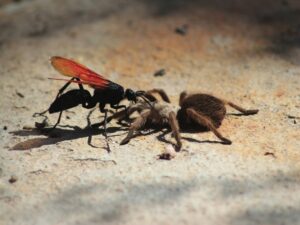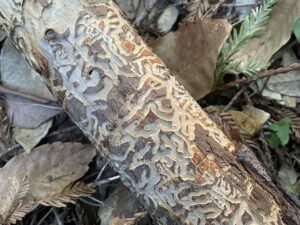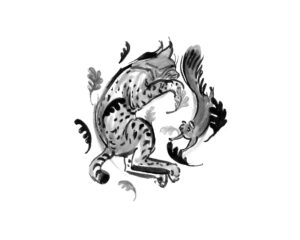Would you believe a twig is watching you? That some leaves can walk? And that if you brush against a piece of bark, it just might fly away?
Insects play “April Fools'” tricks on their would-be predators all the time, hiding from these enemies by either resembling something living and dangerous (mimicry) or looking like a piece of the environment (crypsis). Sometimes, their predator enemies turn the trick table over on insects, and hide themselves in flowers and leaves.
- Inchworm
Inchworms—so called because of the way they “inch” along in a slow, loopy fashion—are actually the caterpillar stage of geometrid moths (a common kind of moth found locally and elsewhere). These inchworms are a great example of crypsis: They look like a twig when they’re standing still. And I do mean standing! These mimics will extend their bodies for hours at a time to resemble an inedible twig, appearing to birds as just another dry, brown piece of the scenery. Instead of standing up, the geometrid moth adults lie flat, holding their wings flat against the surfaces they rest on. When they’re on a tree, their resemblance to bark may save them from being a bird’s lunch.
Our local, large green katydid, Microcentrum, resembles a leaf in shape, with the veins on its wings thickened to appear like leaf veins. Its slow movements are hard to detect, and when it does move, it blends into the background of a bush or tree. Katydids in the tropics appear to have holes, fungus spots, and pieces chewed out of them, all part of a scheme to resemble an unappetizing piece of the forest and avoid being eaten. Recently, researchers reported finding a fossil leaf-mimic insect that is well over 40 million years old.
There are insects that look like gravel, thorns, flower petals, and sticks, but the prizewinners might be the swallowtail butterflies, whose caterpillar stages can closely resemble bird droppings, complete with a greasy-looking dark portion and crystalline-white part. (Look at a real bird dropping and you’ll see the resemblance immediately.) The orangedog swallowtail of the eastern United States keeps the resemblance throughout its caterpillar life; our anise swallowtail’s last two larval stages are green with orange spots, to blend in with the plant it feeds on.
On the other side of the equation, many spiders are sit-and-wait predators, but those who work without a net need to blend into their surroundings to surprise their next meal. Waiting to catch bees or flies, crab spiders are famous for blending in; they can be more (or less) white, yellow, or red, depending on the color of the flower they are sitting on.
- Hoverfly
Birds that have been stung by yellow-and-black wasps or bees (yes, birds get stung too!) can be reluctant to attack anything else that has the same color scheme. Hoverflies, for example, mimic the colors of bees and wasps and are protected from bird predators by that resemblance. Sometimes you can find a flower-camouflaged spider that has caught a wasp-mimicking fly; the combination of crypsis (looking like the environment) and mimicry (looking like another living thing) will remind you that nature’s bag of tricks is never empty, and always evolving!
Get out!
Ever wondered what it’s like to be a bee? Lucky for you, your neighborhood hive is having an open house. Through May, the Randall Museum‘s Journey into the Hive exhibit offers visitors a honeybee’s day-in-the-life experience full of honeycomb cells, queen bees, and lots of wax. On Saturday, April 21, the Randall celebrates Bug Day, a bonanza of slithering, creeping, crawling critters. [Bug Day: 10 a.m.-2 p.m.; free; no RSVP; www.randallmuseum.org, (415)554-9600.]
On Saturday, May 5, don’t miss Sarah’s Science’s Bug Safari at Sunol Regional Wilderness, led by intrepid small-game hunters Alan Kaplan, Norm Kidder, and Jan Southworth Kidder. Get ready to get wet as the safari ventures into Sunol’s streams and fields in search of the mysterious bugs bound to be found. Safari survivors can join the intrepid explorers for a picnic afterward, but pack your own sack lunch. Sarah’s Science Bug Club will also be meeting on April 21 for Mantis Mania, where you’ll learn about mantids and get a chance to take home eggs to hatch and raise yourself. [Safari: 10 a.m.-12 p.m., $35/family (up to five), $5/vehicle; no RSVP. Club: 10 a.m.-11:30 a.m. or 12:30 p.m.-2 p.m., $20/child; no RSVP; sarahsscience.com/pages/bug.html, (510)581-3739.]
Keep on bugging at the Youth Science Institute’s Insect Fair on Saturday, May 19, at the Sanborn Science and Nature Center in Saratoga. Among the fair’s many-legged visitors will be millipedes, tarantulas, ladybugs, and Malagasy hissing cockroaches. Check out the butterfly exhibit, bug-oriented bake sale, silk-spinning demonstration, and arts and crafts opportunities. [10 a.m.-4 p.m., $5/vehicle; no RSVP; www.ysi-ca.org, (408)356-4945].
P.S. Mark your calendar for International Pollinator Week from June 24-30. It’s especially important this year, with mysterious colony collapses threatening the honey bees that pollinate the plants that make up about a third of an average American’s diet, and the healthiest third, at that! To find out more about Pollinator Week, visit www.pollinator.org. To read about Colony Collapse Disorder in the New York Times, click here.






